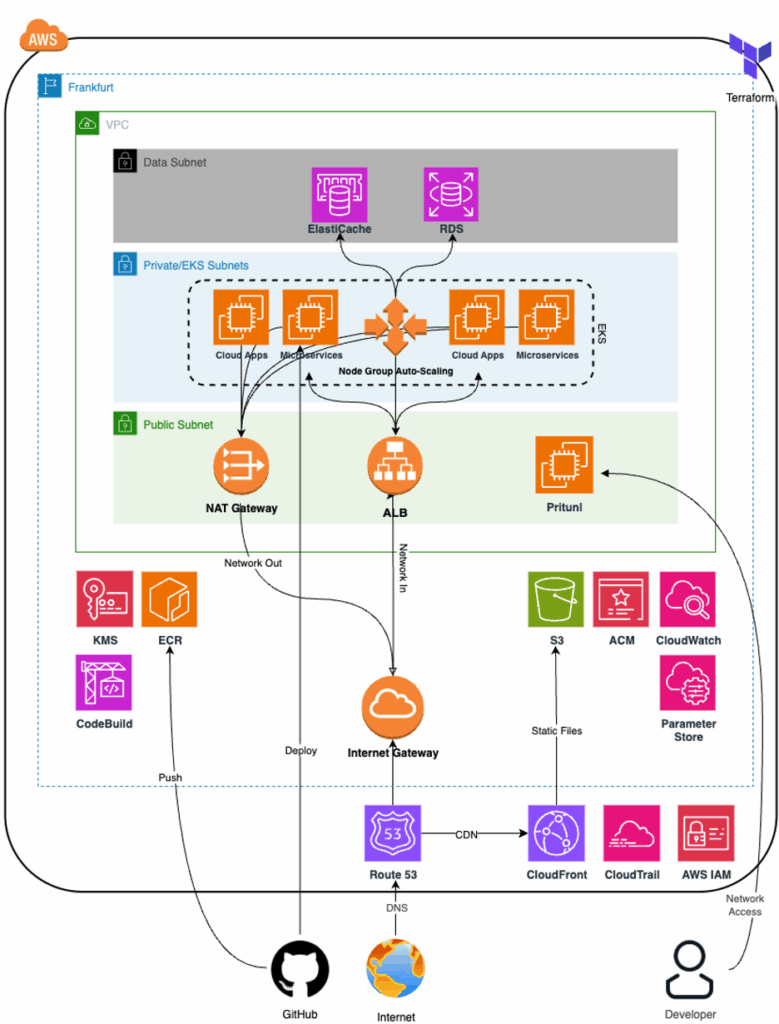
Customer Challenge
Bugece faced serious performance and scalability challenges with its legacy on-premises infrastructure. Relying on a single physical server hosting all applications and databases, the monolithic architecture frequently experienced outages and slow response times during peak traffic periods such as promotional campaigns and high transaction hours. These disruptions significantly impacted customer satisfaction and limited the platform’s ability to grow.
One of the most critical issues was the slow loading of image content across the platform. This resulted in long page load times, which negatively affected conversion rates and user engagement. Compounding this, performance bottlenecks in the payment system led to transaction delays, causing failed checkouts and lost revenue.
The absence of a robust monitoring system made it difficult for the operations team to identify and resolve issues proactively. Deployment processes were fully manual, delaying feature rollouts and increasing operational risk. The lack of structured CI/CD pipelines further added to inefficiencies and made rollbacks complex and risky.
Partner Solution
To address these challenges, we designed and implemented a modern, scalable AWS-based architecture—with Amazon CloudFront playing a central role in resolving Bugece’s content delivery bottlenecks.
The migration began with the setup of a secure and highly available Virtual Private Cloud (VPC), segmented into public, private, and database subnets. Applications were containerized and deployed on Amazon EKS for orchestration flexibility. However, to directly tackle the performance issues around static content and media loading, CloudFront was prioritized as a key service in the new architecture.
Amazon CloudFront was integrated as a content delivery network (CDN) in front of S3 and web applications to accelerate the delivery of static assets like images, scripts, and stylesheets. By caching content at edge locations around the globe, CloudFront dramatically reduced latency and offloaded traffic from origin servers. This ensured that even during high-traffic periods, users experienced consistently fast page loads.
To enhance performance further, CloudFront was also configured to cache and deliver dynamic content such as payment-related pages, ensuring lower response times and smoother checkout experiences. This significantly improved the reliability and speed of critical transaction paths.
Other architectural enhancements included:
- Amazon RDS Aurora PostgreSQL for a high-performance, resilient database layer.
- Amazon ElastiCache Redis to improve real-time data access and reduce application latency.
- Elastic Load Balancer (ELB) to distribute incoming traffic across EKS pods.
- Horizontal and Cluster Autoscaling to dynamically scale infrastructure based on real-time load.
- Prometheus, Grafana, and Amazon CloudWatch for end-to-end monitoring and observability.
- Amazon ECR and rolling update strategies for zero-downtime application deployments.
- AWS Key Management Service (KMS) and AWS Trusted Advisor for enhanced security and cost optimization.
Results and Benefits
The integration of Amazon CloudFront played a pivotal role in transforming Bugece’s user experience. Image and static asset delivery performance improved by over 60%, leading to faster page rendering and higher conversion rates. By offloading requests to CloudFront edge locations, the origin servers experienced reduced stress, resulting in greater availability and resilience.
Checkout-related latency was also drastically reduced. By caching dynamic components via CloudFront and optimizing backend performance with Aurora PostgreSQL and Redis, application response times improved by 40%.
Real-time monitoring through Prometheus, Grafana, and CloudWatch provided full visibility into application and infrastructure health, enabling the operations team to proactively resolve issues before they impacted users.
Automated deployments using Amazon ECR and rolling update strategies significantly reduced downtime and accelerated feature rollouts. CloudFront’s built-in security features ensured secure delivery of content, while KMS and Trusted Advisor added extra layers of protection and cost efficiency.
Overall, this CloudFront-driven AWS modernization empowered Bugece with a scalable, secure, and high-performance infrastructure that meets the expectations of today’s digital users. The platform is now future-ready—capable of supporting rapid growth, delivering reliable service, and maintaining customer trust.



